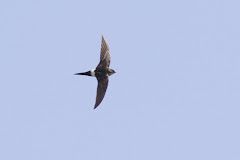





Photos (top to bottom): Isles of Scilly as viewed by NASA; Woodchat Shrike (from southern Europe); Blackpoll Warbler (American); Blyth's Pipit (from Asia); Osprey (this individual from Norway apparently); and the "twitch" of birders looking for the Blyth's Reed Warbler on Bryher
The annual birding pilgrimage to the Isles of Scilly (known by the locals as "Scilly") took place from 13-20 October with expectations high for a bumper autumn. Every year 100s of birdwatchers gather on the "Fortunate Isles" to witness the extraordinary concentration of scarce and unusual birds that congregate on Scilly at this time of year. Over the last 30 years Scilly has gained itself a reputation as THE place in Europe to see a selection of both Eastern (Siberian) and Western (North American) birds, often in the same location. The reason why such birds end up on Scilly in October is still something of a mystery but certainly its geographic location (nearly 30 miles south-west of Land's End) and the fact it's an archipeligo help to explain why Scilly has one of the largest and most diverse list of species recorded anywhere in Europe. The prevailing westerly airflows across the Atlantic, coupled with the regular storms that rush across the Atlantic at this time of year, help to explain the arrival of some American migrants but the regular appearance of vagrants from the Far East is not so easy to fathom.
Islands in general are known to act as magnets, attracting tired and hungry migrating birds that need to rest and refuel, and also weather-driven, exhausted and lost birds that simply have no other place of refuge. Given its geographic location, Scilly is well-positioned to funnel in such birds that are within visible range.
This year, the crack team of me, John Harris, Andrew Harriss (yes, that is the correct spelling), Tim Hemmings and Peter Ransome arrived on the islands on Saturday lunchtime, keen to see the American birds already present on the main island, St Mary's - two Blackpoll Warblers, a Grey-cheeked Thrush and a Wilson's Snipe. Through the week we were also lucky enough to see Blyth's Reed Warbler (a very rare visitor from Eastern Europe and Asia but skulking, brown and boring), two Little Buntings (one of which was found by Tim and me), a Pallas's Warbler (found by Andrew H), at least two Red-breasted Flycatchers, a Blyth's Pipit (extremely rare and also brown and boring) and lots of Yellow-browed Warblers (very small and active and certainly not brown and boring).
As is tradition there was a nightly "log" at the Scillonian Club at 9pm where the local bird group logs all the sightings from across the islands. Photographers, authors, artists and travel companies advertise their wares at stands in the Club and it is generally the place to be and be seen in the birding world.
The islands hold a special place in most birders hearts. The five inhabited islands of St Mary's (the largest), Tresco, Bryher, St Martin's and St Agnes are, in my view, one of the most beautiful parts of the British Isles and to see such good birds concentrated in such beautiful surroundings is a stunning combination. The (almost complete) absence of cars, especially on the 'outer islands' is a pleasant change from the mainland and the islands' selection of pubs and restaurants, serving local ales and fantastic local fish dishes, make for an excellent refuge in the evening after a hard day 'in the field' where birders can exchange stories of the day's birding, including the 'ones that got away' - brief glimpses of "possibles" and "probables" that flitted away before identification could be clinched. An October on Scilly never passes without rumours of the presence of a "mega" - a bird that has only ever been recorded in the UK 5 times or less - most of which never come to anything. But the anticipation that it just might be the real thing always excites and increases the intensity with which birders search fields, hedgerows, trees and bushes just in case a "first for Britain" is lurking inside...
In the 1980s the number of birders staying on the islands reached a peak of around 1200. This year the estimate was around 350. The reason for the decline is the increase in fast information. Years ago, news of rare birds was spread via postcard or, if you were lucky enough to have a telephone, by a call. Any birder who cared about his British list based him/herself in the most likely location for vagrants - Scilly. Nowadays there are websites, mobile phones and pagers that give up-to-the-minute information about the precise location of the rare birds that are in the UK at any time. This means that many "listers" (those birders who give greatest priority to increasing their "British life list" - the number of bird species they have seen in Britain) like to stay on the mainland just in case that new bird turns up on Shetland or in Norfolk instead of Scilly. They no longer gamble by spending a week in the most likely location of rare birds. If something good does turn up on Scilly, they "day-trip" the islands, see the bird then leave.
For us, the enjoyment of a week on Scilly in Autumn seeing whatever birds are there, whether they are new "ticks" or not, is the reason we go. There is surely nowhere else in Europe where you can see such good birds in such a beautiful environment with many people who share your passion. A top, top week made all the better by the lack of crowds. Here's to Scilly 2008!





